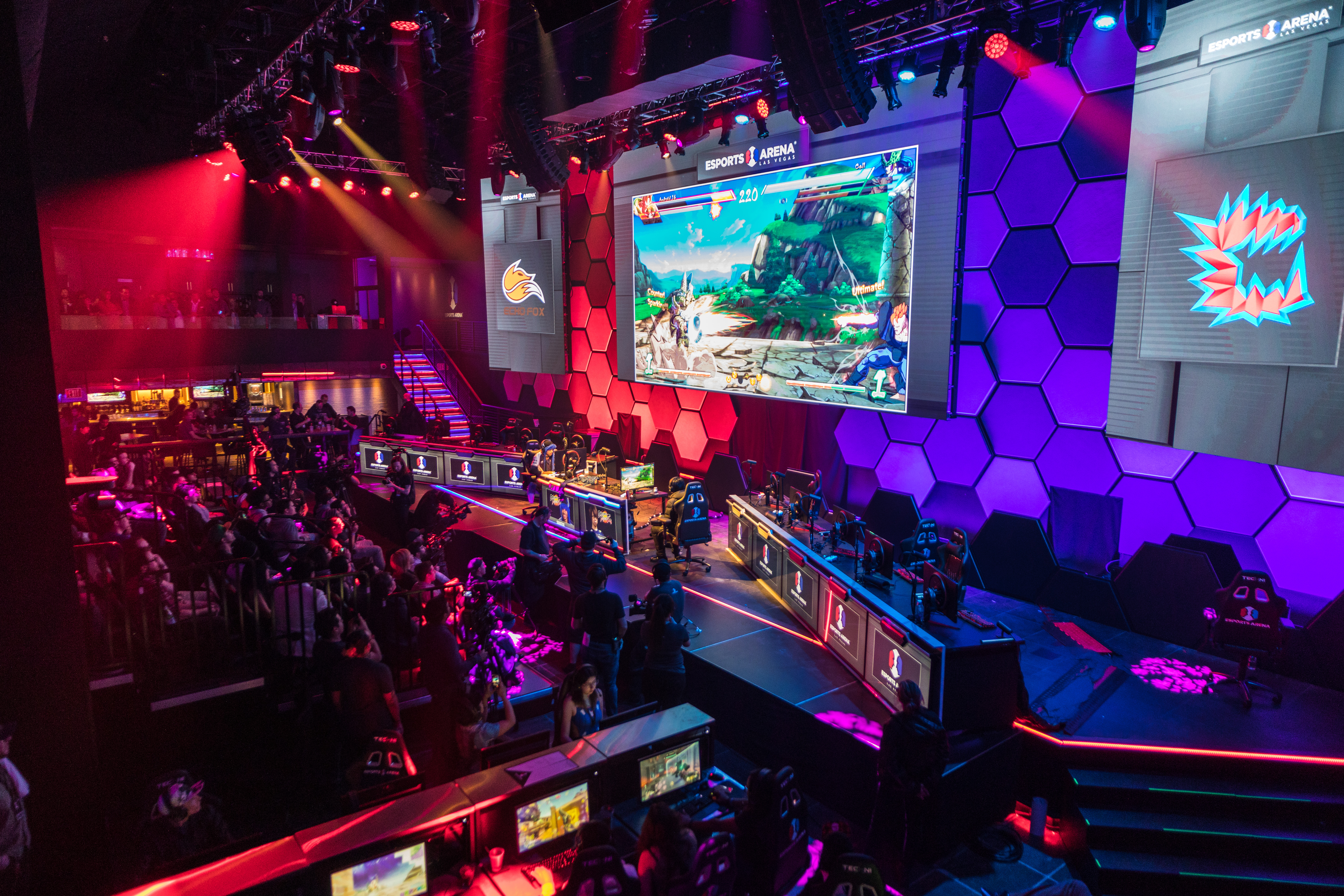Esports in trending in pro AV, there’s no doubt about it, but is the pro AV industry ready for esports? Here’s what you need to know about this hot topic.

Esports installations appear to be vastly different from a typical AV installation. According to Dave Van Hoy, president of Advanced Systems Group, “A ‘normal’ AV installation for a sports arena, for example, displays statistics, replays, maybe some advertising, and the live feed from one camera. But the main action is on the field. For esports, the audience is only seeing the game action through the AV system. Yes, you’ll want cameras on the gamers themselves, too, but those shots are a much less important part of the experience because they don’t show the actual game action.”
In addition, AV equipment in esports arenas needs to have a precise purpose. “I think it’s important for integrators to understand that technology is a tool to help facilitate an experience,” said Joe Dunbar, technical experience champion – visualization, Starin Marketing. Technology, he said, “should contribute to the gamer’s and the audience’s experience without getting in the way. The instant the technology gets in the way or removes them from the world they’re playing in, that’s a problem.”
Eric Cantrell, vice president of business operations at Medialon, agrees: “While there is a desire to make the experience for the crowd and cameras as spectacular as possible, we must remember to stay out of the way of the athletes and let them do what they are there to do, without creating interference or distraction.”
“Since ‘it’s just video games,’ there is a tendency to think the players don’t require the same level of concentration other athletes do, and that’s plain wrong,” he added. “It is equally wrong to design systems that encourage audiences to expect a party atmosphere. There’s serious gameplay happening.”
The Production of Esports
Nearly every esports installation has some type of broadcasting element to it. Whether it’s streaming feeds onto displays or live streaming to millions of people on Twitch, gaming fans are watching.
“The in-house live production aspect is more about the production for the camera than it is for the live audience in the venue, but both are important,” said Cantrell. “You want to create an engaging atmosphere where everyone can see their favorite athletes playing, so a huge component of that is multiplexing the various video streams from the players’ consoles and observer nodes to show the action to the audience from multiple points of view.”
[The Esports Opportunity for the Broadcast, Pro AV, and IT Industry]
That being said, the number of sources and redundancies needed for esports broadcasts are much higher than a typical installation. “You’re not going to find many news studios or talk show sets with dozens of sources,” mused Van Hoy.
Van Hoy pointed to a typical five-on-five esports competition as an example, which would start with a camera for each player and a live feed for each of their screens. That’s 20 separate sources before you even figure in cameras for commentators, audience reactions, wide shots, and overall production value, plus additional inputs for switchers for graphics and instant replays. “The massive number of sources to create an esports broadcast ripples through to monitoring in the control room, where you’ll need a wall of multiviewers to keep track of all your potential shots,” Van Hoy added.
In addition to the visuals, audio will need to be heavily factored into the installation. Like all team sports, communication is key in esports. The key difference is that gamers can’t just pause the game to huddle up, so while you’ll need mics for each gamer, commenter, and the gaming consoles themselves, integrators need to figure out how to manage the team’s chatter. “One team can’t hear the other team’s privileged communications, so you have to be very careful about how audio is routed,” said Van Hoy, who recently led the design team for the Electronic Arts (EA) Broadcast Center production facility at the EA headquarters in Redwood City, CA.
At the EA Broadcast Center, Van Hoy and his team installed two separate Riedel intercom systems, the first of which was a standard production intercom for the crew. The second was specially configured to guarantee that private communications were shared with the broadcast audience but not the competition.
Technical Challenges
Large-scale video walls seem to be at the heart of any experience-oriented installation, esports included. When video walls are added into an esports center, they can spell trouble if not implemented properly. Few glitches can distract from the broadcast more effectively than visible moiré patterns.
Dunbar finds this challenge exciting because he believes video wall innovations are coming out at a rapid pace to address challenges exactly like this. “For integrators, a tight pixel pitch goes a very long way,” he said. “This is specifically why companies like Neoti are finding success with the broadcast and house of worship markets.”
Van Hoy recommends adding a high-quality video scaling product into the mix because of the amount of motion used in gaming. In addition, “to avoid or minimize these distracting patterns, you need to use three-chip cameras, which tend to be expensive, at a very high shutter speed. Currently, Ikegami is the hands-down leader in esports, as their cameras include physical and DSP filters optimized to eliminate moiré patterns.

Another potential pitfall integrators are certain to face during esports installations is latency. A delay of even one millisecond can lead to an on-screen death for a gamer … and that could be a big financial loss in an esports tournament. “Latency is an issue for live audiences and, of course, the players. That means that whatever you’re doing, you can’t introduce lag between the video output of the computers and the displays the players are using to play the games,” explained Cantrell.
He recommends splitting the signal, sending one feed to the broadcast booth and keeping the other signal local to the player. “From that point, if you stick with broadcast-quality technology for video switching and compositing, you’re going to be ‘good enough’ for the live audience.”
[Esports is the Pop Culture Change We Need]
Starin’s Dunbar explained that there are several methods for signal transport for esports installations. “Everyone’s AV-over-IP solutions are improving daily and reducing latency times to nearly nothing.” He added that HDBaseT has zero latency and is an “easy, affordable, highly reliable method to move video.” Dunbar believes that SDVoE is “more relevant than ever” for large-scale applications. “As 10 Gb networking solutions become more common and affordable, this is a great way to move high-resolution video with deep color and zero-frame latency.”
The Experience of Esports
Lastly, those integrating esports facilities need to think about the razzle-dazzle factor for the audience experience. Lighting, for example, can be used to “guide an audience’s eyes to which players are battling it out,” Cantrell said. Color-coded lighting can also be used to signal big moves or a particular gamer’s play.

But integrators don’t have to think about the experience alone. “I would encourage all partners to embrace content creation and creative people who offer that service,” said Dunbar. “The transport and execution mean nothing without a message to deliver.”
“I’d love to tell you that I’m some type of visualization wizard, but the reality is that I’m here to facilitate some of the highest-quality partners in the industry in mutually invested relationships that support one another’s growth,” emphasized Dunbar. “We win and lose together.”
A Lucrative Future
Esports is buzzworthy and can be a lucrative market for integration firms, consultants, and pro AV manufacturers. According to Newzoo, a gaming analytics firm, global esports revenues were expected to reach $906 million in 2018, with $345 million of the total coming from North American markets. With continued growth, there will be plenty of new builds for integrators to capitalize on.
“Esports is not a flash in the pan,” concluded Cantrell. “It’s been around for a long time. Remember the 1989 Fred Savage movie The Wizard? And it’s here for the long haul.”
BONUS: Esports Facts & Figures
In late 2018, global games and esports analytics provider Newzoo published its 2018 Global Esports Market Report. Here are some facts and figures from the document.
- In 2017, the total esports viewing audience was 335 million. By 2018, the audience had grown to 380 million—with 215 million occasional views and 165 million enthusiasts (i.e., people who regularly watch esports).
- By 2021, the esports viewing audience is projected to reach 557 million. That’s an approximate annual growth rate of 14 percent.
- Global esports revenues were predicted to reach $905.6 million in 2018, an increase of more than $250 million compared to 2017. North America was expected to generate the most revenue, contributing 38 percent of the global total in 2018.
- In 2017, there were 588 major esports events that generated an estimated $59 million in ticket revenues, up from $32 million in 2016.
- The League of Legends World Championship was the most watched event on Twitch in 2017, with 49.5 million hours. It also generated $5.5 million in ticket revenues.

